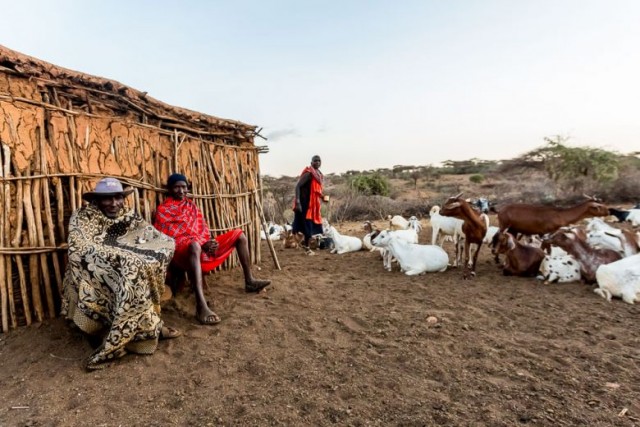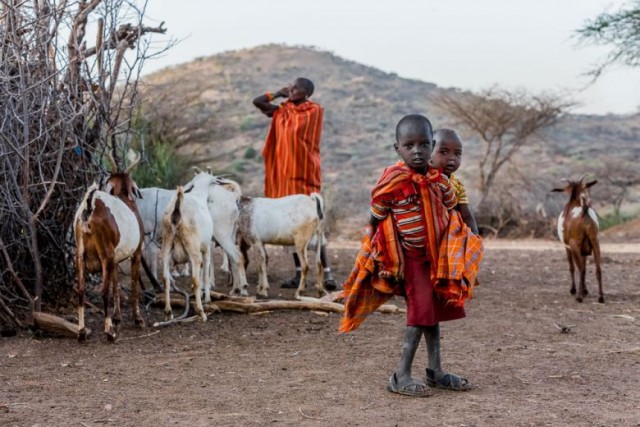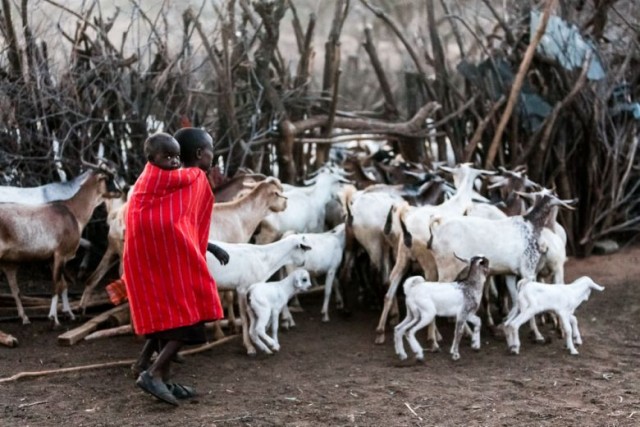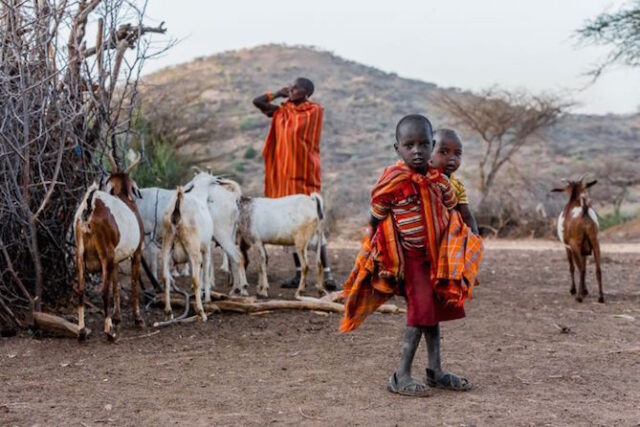This post by Susan Portnoy originally appeared on TakePartWorld on November 4, 2015.
It was a mild September night, and I was in Kenya’s northern frontier district, Laikipia. The Samburu Trust had arranged for me to spend a couple of hours with a Samburu elder and his family, including two of his five wives and their children. It would be a fly-on-the-wall visit. I didn’t want anyone to make a special effort or reenact a cultural tradition, nothing manufactured for the curious traveler. I just wanted to capture—as inconspicuously as a stranger with a camera could—a tiny slice of their everyday life.
It was twilight when Leuya, my Samburu guide, and I arrived at Mzee Lekolua’s manyatta (the Samburu term for “home” or “compound”). Lekolua welcomed us, staff in hand, surrounded by dozens of his goats. The Samburu are pastoralists, so cows and other livestock are what establishes a man’s rank in society and are the cornerstone of Samburu wealth. By the tribe’s standards, Lekolua was one of the richest in the region.
Night was falling, and there was much to do. The goats had to be counted, milked, and put to bed. Lekolua’s wives and children zigzagged around me in a rush of controlled chaos as they tucked the manyatta in for the night.

Photo credit: Susan Portnoy
My guide Leuya is a man torn between Western influence and Samburu tradition—education being the catalyst. Estranged from her husband and unable to feed her children, Leuya’s mother sent him as a boy to live with missionaries. They sent him to school, and he grew up learning Swahili and English. His teachers forbade the tests of courage young Samburu boys go through as they approach adulthood: He didn’t have his two lower front teeth removed, his ears showed no sign of piercings, and he didn’t boast the scars the young men etch into their skin. He was never a warrior, also known as a moran, a role Samburu men are bred for from an early age. He was, however, circumcised in a sacred public ritual that celebrates a boy’s ascension into manhood.
When Leuya was young, the elders thought less of him because his upbringing didn’t follow the conventions of the tribe. It wasn’t until his education led to a good job as a guide at the nearby Ol Malo Lodge, where I was a guest, that his status changed. His steady income enables him to buy things most Samburu cannot afford, as well as help support his 21 brothers and sisters. Today he has the respect of the community, but he has never lost the feeling of being an outsider.

Photo credit: Susan Portnoy
The manyatta is circular and surrounded by a thorny acacia fence to ward off predators. Inside is a second thorn-less pen for livestock and a two-room house that belongs to one of the wives, in this case, Lekolua’s second wife, Nalusha. Lekolua visits each wife’s manyatta periodically.

Photo credit: Susan Portnoy
As patriarch, Lekolua (sitting in red) is responsible for arranging his children’s marriages. Men marry in their mid- to late-20s after spending a few years as a moran. The police of the tribe, the moran are the warriors. They protect their villages against conflicts with other tribes and predators. Girls are married as early as 14, often becoming the second or third wife to men who are decades older but are considered a good match because they have lived long enough to own a lot of cows. In this photo, Lekolua relaxes with a friend while his wives and children look after the goats.

Photo credit: Susan Portnoy
Longuta, Lekolua’s first wife, had her two front bottom teeth removed when she was a girl. All traditional Samburu remove these teeth so that liquids and herbal medicines can be administered if they contract lock-jaw owing to tetanus. Tetanus blossoms in cow feces, and as pastoralists, the Samburu have plenty to go around. Combine that with a landscape full of three-inch acacia thorns, and contracting the disease from a puncture wound is not uncommon. Over generations, this custom has also become a test of courage for young boys, who are successful if they endure the procedure without showing pain or emotion.

Photo credit: Susan Portnoy
In the middle of all the activity, Longuta’s hungry son waits patiently while she milks a goat, its hind leg wedged between her legs and a hungry kid at her heels. She collected the milk in a mug, and he drank it on the spot.

Photo credit: Susan Portnoy
Jewelry is an important part of the Samburu culture. The hoop and chain in Nalusha’s ear indicates that she’s married. In addition to letting others know an individual’s status, it plays an important role in self-expression.

Photo credit: Susan Portnoy
Samburu children have many responsibilities at an early age. In addition to helping with the goats, this young man was charged with minding his little brother, whom he carried on his back for most of the evening.

Photo credit: Susan Portnoy
Women are the heavy lifters in Samburu society. They build the homes from wood and a mixture of clay found in ant hills and cow dung, fetch the water, assist with the livestock, cook the meals, raise the children, and make the jewelry that they wear and sell to travelers or merchants from neighboring districts.

Photo credit: Susan Portnoy
One of the boys herds the goats back into the pen after they’ve been counted and milked. The youngest of the 20 baby goats will sleep in the house to keep them warm.

Photo credit: Susan Portnoy
Day or night, it’s always pitch-black in a Samburu home, save a few tiny holes in the construction that allow shafts of light to slip in. To Nalusha’s right is the entrance to the room she shares with Lekolua when he visits. The children sleep in the main room, which is behind the camera. I took this photo from the guest bed, a raised platform made of wood covered in cowhide.
Susan Portnoy is a communications and public relations consultant who writes and photographs for her site, The Insatiable Traveler. She also contributes to Yahoo Travel, Wendy Perrin, and Solo Traveler and is a blogger on The Huffington Post.
The Samburu Trust is an organization in Laikipia, Kenya, that works in collaboration with the Samburu tribespeople to identify the needs of the community and to develop solutions.



